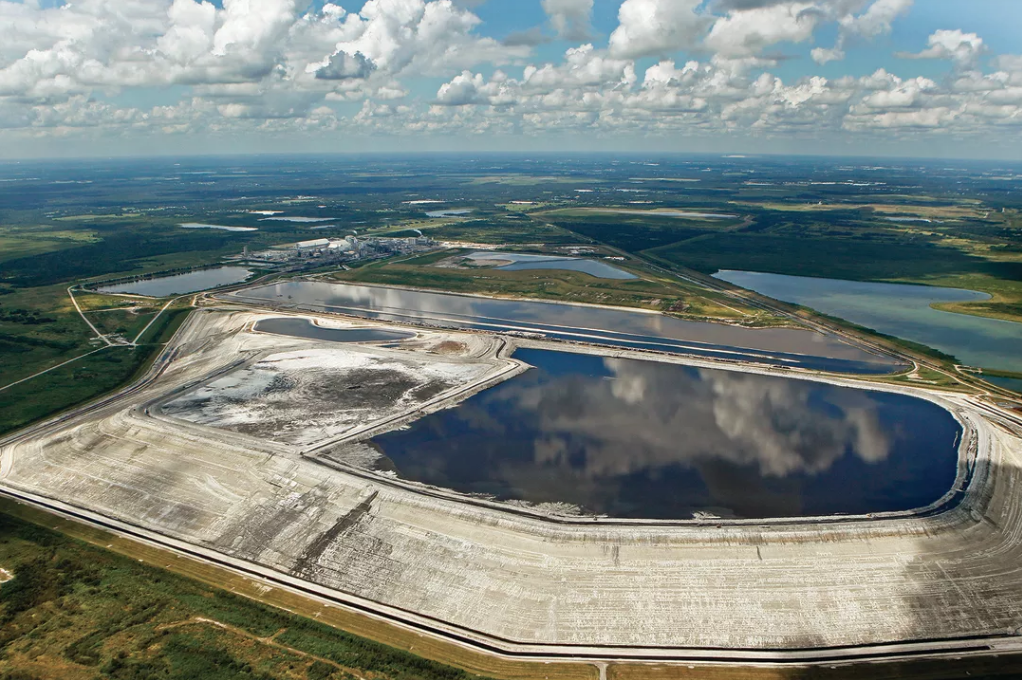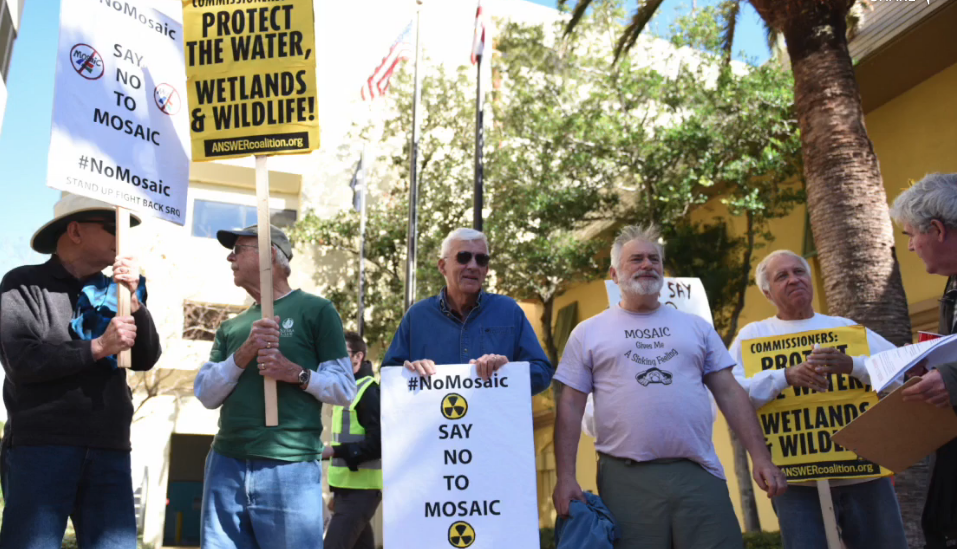Several 3PR members attended the Board of County Commission meeting and had important comments to make under oath to the Commissioners. Link is to the Herald Advocate newspaper report about the meeting.
Category: News Articles
Company ordered to pay Idaho tribes for toxic waste storage

BOISE, Idaho (AP) — An agribusiness company that turned phosphate into fertilizer must pay $1.5 million in permit fees annually to eastern Idaho tribes to store millions of tons of toxic waste on tribal lands, a federal court has ruled.
Continue reading “Company ordered to pay Idaho tribes for toxic waste storage”
The Clock is Ticking on Florida’s Mountains of Hazardous Phosphate Waste
The largest fertilizer manufacturing plant in the world sits about six miles southwest of the Polk County hamlet of Mulberry, with its entrance in walking distance of the Hillsborough County line. About 800 employees work there, turning phosphate rock into nearly 5 million tons of fertilizer and animal food ingredients every year.
They also produce a lot of waste. That’s not unusual for the phosphate industry.
Drive through much of the Florida peninsula and the land you see is flat—flat as a pancake, flat as a billiard table, flat as a contestant on The Voice who’s about to get the boot. But at the Mulberry plant, and everywhere else the phosphate industry operates, you’ll see mountains. These are massive piles of waste materials called phosphogypsum that are left over from the fertilizer manufacturing process. They rise up to 200 feet high and cover some 400 acres. On top of each one is a pond of acidic water from 40 to 80 acres in size.
Many of those mountains belong to the same company that owns the Mulberry fertilizer plant, Mosaic. It’s the biggest phosphate company in the world and a major presence in Florida. Mosaic is currently mining phosphate rock on more than 70,000 of the 380,000 acres it owns in Manatee, Hillsborough, Polk and Hardee counties. Meanwhile, despite vocal public opposition, it recently won local government approval to expand its mining in Manatee County by more than 3,000 additional acres just a short drive from Sarasota County’s northern boundary—and from the source of its water supply.

Letters to the Editor – Bradenton Times
Letters to the Editor
Bradenton Times
Saturday, Feb 11, 2017
Would mining activities preclude future normal uses of mined out lands? This is question #6 from the Manatee County staff report, Standards for Master Mining Approval, page 13.
The answer is much more than staff reports. Not only building, but agriculture on reclaimed land would be extremely limited. Is the burden of proof not on the applicant? The market has not demonstrated that agriculture is a viable use of reclaimed mine land.
Mosaic may have their small, intensely managed experiments with ag after mining, however, vast areas of western Polk County demonstrate no agriculture to speak of on reclaimed land. The only exception is a rare siting of a few cows on grazing land.
Go to Hardee County. In 2008, a “Mosaic Agreement” granted the county economic gurus 42 million dollars over a ten year period as compensation for the 11,000 acre South Fort Meade Extension mine. The county will tell you is for economic mitigation in the post-mining economy. This money hopes to start up industry, but the results have been questionable at best. Is this not an admission even by the industry itself that after mining and reclamation, lands will not support the former economy of agriculture.
One time, temporary use; permanent loss. Phosphate strip mining is only profitable for Mosaic. Commissioners, think ahead one hundred years. Vote for Manatee County. Vote no on phosphate mining.
Brooks Armstrong
Bone Valley resident
Anti-mining group claims FDEP didn’t investigate suspicious water levels before sinkhole
The Coalition to Stop Phosphate Mining announced data they had found about a 40-foot rise in water in the upper containing unit at the north phosphogypsum stack that could have been an indication of a future sinkhole.
3 PR joins Center for Biological Diversity and Manasota 88 and Suncoast Waterkeepers in litigation
Environmentalists will sue if Corps permits Florida phosphate mining

Four environmental groups have put the U.S. Army Corps of Engineers on notice that they’ll sue if the Corps follows through with authorizing phosphate mining on more than 50,000 acres of land in Central Florida. The environmentalists say the strip mining damages wildlife habitat and endangers drinking water and they’re threatening to sue the U.S. Fish and Wildlife Service as well.
WMNF News interviewed Jaclyn Lopez, Florida director of the Center for Biological Diversity, one of the four groups who filed the intent to sue on Tuesday.
“The Army Corps of Engineers has recently approved the phosphate mining development of about 50,000 acres of central Florida and this is predominately in Hardee, Manatee County areas and a little bit in DeSoto County. Most recently, they approved 7,500 acres of mining to start eminently, any moment now, in Hardee County.
Phosphate mining in Florida. By Jaclyn Lopez (used with permission).
“All this mining is going to be taking place in a region known as Central Florida Phosphate District. It’s an area that has seen tremendous phosphate mining over almost the last century. If you go out to that area, which is just east of Tampa, you’ll see the scars from historic phosphate mining.
“Before 1975, phosphate mines didn’t have to be reclaimed. If you’re ever in an airplane over that region of Florida, you’ll see these, sort of really pretty colored bluish-green bodies of water, like lakes, in these strips. That’s the legacy of strip-mining in Florida for phosphate. Since 1975, the companies have been forced to reclaim the land, which is to put it back to some sort of beneficial use, but, not necessarily to restore it.
“Our concern with this 50,000 acres of additional mining is first, it leaves a huge footprint on Florida. You’re removing 50,000 acres of habitat for imperiled species like, the eastern indigo snake and the crested caracara. Also, you’re adding to our existing phosphogypsum problem.
for complete article http://www.wmnf.org/environmentalists-sue-corps-florida-phosphate-mining/
Mosaic scales back well testing for sinkhole neighbors
The Mosaic Corporation is denying their responsibility of continuing to tests wells for the areas surrounding the New Wales Plant where 215 million gallons of radioactive toxic water entered the Floridan aquifer in a sinkhole disaster in August 2016. The FDEP should require the continued testing of any Floridian resident wells who think their well water might be compromised by this enormous “accident”. There are 25 gypstacks in Florida and each one of them has the potential to contaminate our water supply.
Published: December 2, 2016, POLK COUNTY, Fla. (WFLA)
Read Full Article here: https://www.wfla.com/8-on-your-side/investigations/mosaic-scales-back-well-testing-for-sinkhole-neighbors/995214069
Public Records Raise Questions About State’s Sinkhole Response
TALLAHASSEE, Fla. – After making a public records request to the State of Florida for documents about the Polk County sinkhole, and experiencing weeks of delay in receiving a response, Congresswoman Gwen Graham today said that the records which were released raise serious questions about the response of the governor’s office and the Florida Department of Environmental Protection (DEP) to a potential crisis.
“Unless there are records that were not produced as required by law, the disclosures show an alarming lack of communication among state regulators about a threat to the health and safety of Florida families and our environment,” said Graham. “I am very concerned that we had a watchdog agency asleep at the wheel.”
According to the records, before the sinkhole was exposed by the media, nearly all of the electronic communications regarding the incident were email exchanges between the DEP and Mosaic employees. Records from the governor’s office and DEP contained very few internal communications between state employees concerning the sinkhole before it became public. And while there were several emails from the governor’s office about Graham’s questions, there were none demonstrating concern over the sinkhole and DEP’s response or examining potential solutions to the problem.
Equally concerning was the state’s communications with its own scientists, much of which appears to be instructions on how to handle questions from constituents and the press. At least one geologist, who has spent more than 20 years working for the state, raised concerns over the lack of information: “I’m working on that facility with EPA but no one told me about it [the sinkhole]. So much for communication.”
“These public records responses indicate communication has broken down within Governor Scott’s state agencies,” Graham said. “With this kind of threat to Florida families and the environment, the governor’s office and DEP should have been ringing alarm bells and taking swift action. Nothing in these records indicates they were operating with any sense of urgency. Either we are still missing documents, or the state didn’t particularly care. Neither situation is acceptable.”
The records from the governor’s office can be found, here. Emails from DEP can be found, here. Video footage of the sinkhole found in the emails can also be viewed, here.
Every gypstack a potential disaster
Florida Sinkhole Heightens Concerns About Fertilizer Industry
Wall Street Journal on November 13, 2016
“This is a very unfortunate event and one we certainly wouldn’t have wanted to happen to us,” Mosaic Chief Executive Joc O’Rourke said in an interview this month.
The 240-foot-deep hole opened beneath a pile of mining waste at Mosaic’s plant in Mulberry, Fla., about 30 miles east of Tampa, in late August and drained contaminated water into an aquifer that provides drinking water for communities as far north as southern Georgia.
The company in early November said it would spend some $60 million to seal hole with concrete and pump the contaminated water out of the aquifer. Mosaic has also guaranteed Florida $40 million if it fails to take actions like plugging the hole and monitoring nearby drinking-water wells through 2018.
“We take our obligation to our community extremely seriously,” Mr. O’Rourke said. “I have great faith that we will right the issue and ultimately our contribution to society will be much greater than the impacts.”
The phosphate fertilizer that helped nourish the record U.S. corn and soybean harvests this year is made from mining millions of tons of mineral-rich earth. Environmentalists say the wastewater and towering mountains of refuse left behind by the fertilizer-manufacturing process take too big a toll.
At Mosaic’s plant in Mulberry, millions of gallons of acidic water created during fertilizer production spilled into the aquifer, along with unknown quantities of phosphogypsum, a mildly radioactive fertilizer byproduct.
“Phosphate production does enormous damage even when everything goes right,” said Bradley Marshall, an attorney at Earthjustice, a nonprofit environmental-law group. He said the porous limestone surrounding the local water table car easily allow pollutants to spread.
“The Florida aquifer is like Swiss cheese,” he said.
Mosaic said water in the aquifer moves slowly, allowing the company to retrieve the contaminated water before it flows off its property.
Mosaic has had trouble with mining waste before. Last year, the company struck a deal worth more than $800 million with regulators to clean up hazardous waste from its operations in Louisiana and Florida.
In September, residents near Mosaic’s Mulberry sinkhole sued to hold the company responsible for potential drinking-well contamination. Days later, Governor Rick Scott ordered Florida’s environmental protection department to issue an emergency rule requiring businesses and local governments to inform the public and the department within 24 hours of a pollution incident.
Samples from more than 900 private wells nearby show no effects from the spill, the state environment department said.
The Mosaic facility processes phosphate rock from a swath of central Florida known as Bone Valley for its fossil beds that harbor the mineral. Florida supplies roughly 70% of the phosphate rock for U.S. fertilizers. Manufacturing fertilizer leaves behind mounds of refuse called phosphogypsum stacks—or gyp stacks—which pockmark the landscape. Collectively, they cover thousands of acres and each can reach 500 feet high.
“Each is a disaster waiting to happen,” said Beverly Griffiths, chairwoman of Sierra Club Florida’s phosphate committee. The Sierra Club implored the U.S. Army Corps of Engineers to freeze new mining permits until the industry’s effects are better understood.
A sinkhole opened in 1994 under the same gyp stack in Mulberry, then owned by IMC Global Inc. Mosaic said the sinkhole was repaired at the time and that no other work was needed once they took over the facility. Mosaic said contamination didn’t escape the property then, either.
Another Florida fertilizer maker, Mulberry Corp., filed for bankruptcy and abandoned a plant in 2001, leaving officials to pump wastewater onto a barge and dump it in the Gulf of Mexico. In 2009, another sinkhole emptied more than 90 million gallons of hazardous wastewater into the Florida aquifer, the Environmental Protection Agency said.
Environmentalists said the latest breach validates their warnings about phosphate mining’s dangers. Some want more regulation. Some want to stop fertilizer production completely.
Brian Birky, executive director at the Florida Industrial and Phosphate Research Institute, said the U.S. can’t do without the fertilizer mined there. Over the past half-century, the U.S. has seen an increase in the use of phosphate-based fertilizer as well as high-tech seeds and equipment, pushing crop yields ever higher.
Mosaic’s Mr. O’Rourke said consumers benefit from the low food prices those yields make possible. He said U.S.-made fertilizer will be necessary to produce the calories to feed a booming global population.
“If you want to feed eight to nine billion people, you have to do it using mined and manufactured fertilizers,” he said. He expects phosphate mining in Florida to continue for at least 40 more years.
“The idea of 40 more years of mining in central Florida is revolting,” said Jacki Lopez, staff attorney and director of the Center for Biological Diversity in Florida.
“It’s radioactive waste,” Ms. Lopez said. “Where does all that go?”
Write to Jesse Newman at jesse.newman@wsj.com
MOSAIC SPILL: AQUIFERS 101
Bradenton Times
John Rehill
Friday, Sep 23, 2016
Mosaic officials claim that 215 million gallons of contaminated water was sucked down into the Floridan aquifer system through a massive sinkhole underneath their phosphogypsum stack at the company’s New Wales fertilizer plant in Mulberry, Florida. A closer look at both the evidence and Mosaic’s history suggest this shouldn’t have been much of a surprise.
David Jellerson, senior director for environmental and phosphate projects at Mosaic, says he is confident no contaminants will migrate offsite. He claims Mosaic’s monitoring wells will capture the fugitive chemical mixture and that there is “no risk to the public.”
Mosaic officials first reported the breach to the public three weeks after they claim two workers—said to be monitoring the fluid levels in the stack—noticed the drop, indicating a problem. It was then, the company claims, that pumps were installed to retrieve the remaining fluid in the stack in search of the calamity’s origin.
Read more http://thebradentontimes.com/mosaic-spill-aquifers-p16872-137.htm#.V-rTbmvgny8.facebook


